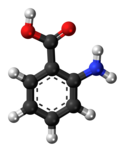Anthranilic acid
|
|
|||
| Names | |||
|---|---|---|---|
|
IUPAC name
2-Aminobenzoic acid
|
|||
| Other names
o-Aminobenzoic acid; 2-Aminobenzoic acid; Vitamin L1; Anthranilate
|
|||
| Identifiers | |||
|
118-92-3 |
|||
| 3D model (Jmol) |
Interactive image Interactive image |
||
| ChEBI |
CHEBI:30754 |
||
| ChEMBL |
ChEMBL14173 |
||
| ChemSpider |
222 |
||
| DrugBank |
DB04166 |
||
| ECHA InfoCard | 100.003.898 | ||
| EC Number | 204-287-5 | ||
| KEGG |
C00108 |
||
| PubChem | 227 | ||
| RTECS number | CB2450000 | ||
|
|||
|
|||
| Properties | |||
| C7H7NO2 | |||
| Molar mass | 137.14 g·mol−1 | ||
| Appearance | white or yellow solid | ||
| Odor | odorless | ||
| Density | 1.412 g/cm3 | ||
| Melting point | 146 to 148 °C (295 to 298 °F; 419 to 421 K) | ||
| Boiling point | 200 °C (392 °F; 473 K) (sublimes) | ||
| 0.572 g/100 mL (25 °C) | |||
| Solubility | very soluble in chloroform, pyridine soluble in ethanol, ether, ethyl ether slightly soluble in trifluoroacetic acid, benzene |
||
| log P | 1.21 | ||
| Vapor pressure | 0.1 Pa (52.6 °C) | ||
| Acidity (pKa) | 2.14 | ||
| -77.18·10−6 cm3/mol | |||
|
Refractive index (nD)
|
1.578 (144 °C) | ||
| Thermochemistry | |||
|
Std enthalpy of
formation (ΔfH |
-380.4 KJ/mol | ||
| Hazards | |||
| Safety data sheet | External MSDS | ||
| R-phrases | R36 R37 | ||
| S-phrases | S26 S39 | ||
| NFPA 704 | |||
| Flash point | > 150 °C (302 °F; 423 K) | ||
| > 530 °C (986 °F; 803 K) | |||
| Lethal dose or concentration (LD, LC): | |||
|
LD50 (median dose)
|
1400 mg/kg (oral, rat) | ||
|
Except where otherwise noted, data are given for materials in their standard state (at 25 °C [77 °F], 100 kPa).
|
|||
|
|
|||
| Infobox references | |||
Anthranilic acid (o-amino-benzoic acid, 2-aminobenzoic acid, 2-AA, 2AA, AA) is an aromatic acid with the formula C6H4(NH2)(CO2H). The molecule consists of a substituted benzene ring, hence is classed as aromatic, with two adjacent, or "ortho-" functional groups, a carboxylic acid and an amine. The compound is consequently amphoteric. In appearance, anthranilic acid is a white solid when pure, although commercial samples may appear yellow. It is sometimes referred to as vitamin L1 and has a sweetish taste. The anion [C6H4(NH2)(CO2)]−, obtained by the deprotonation of anthranilic acid, is called anthranilate.
Although not usually referred to as such, it is an amino acid. Solid anthranilic acid consists of both the amino-carboxylic acid and the zwitterionic ammonium carboxylate forms.
Many routes to anthranilic acid have been described. Industrially it is produced from phthalic anhydride, beginning with amination:
The resulting sodium salt of phthalamic acid is decarbonylated via a Hofmann rearrangement of the amide group, induced by hypochlorite:
A related method involves treating phthalimide with sodium hypobromite in aqueous sodium hydroxide, followed by neutralization. In the era when indigo dye was obtained from plants, it was degraded to give anthranilic acid.
Anthranilic acid was first obtained by base-induced degradation of indigo.
Anthranilic acid is biosynthesized from chorismic acid. It is the precursor to the amino acid tryptophan via the attachment of phosphoribosyl pyrophosphate to the amine group.
...
Wikipedia



